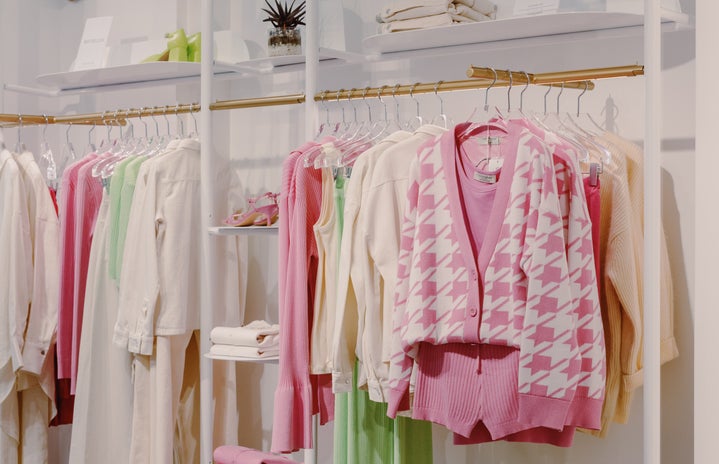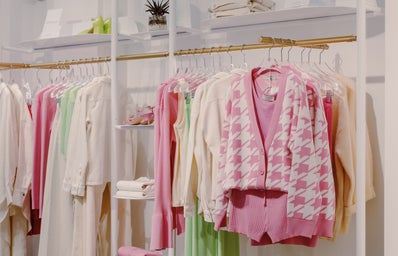The boost of social media in recent years, namely TikTok, has been beneficial for accessibility and ease when browsing and looking for fashion inspiration, since finding a sense of personal style can sometimes be challenging when figuring out how to express oneself through how we look and feel in the clothes we wear.
The rise of social media has, however, come with its issues. TikTok’s popularity has proved fatal to the fashion industry as unethical, fast fashion brands such as Shein, Pretty Little Thing, Boohoo – just to name a few – have taken to marketing their products on the platform, reaching millions of viewers per day. The negative impact of this comes from the fact that unsustainable fast fashion brands commonly centre themselves around microtrends: clothing trends promoted by brands that are only expected to last a couple of years or months even. Microtrends have varied from the comeback of older clothing items, for example, the re-popularisation of flared jeans in recent years. Such trends in this sense can be beneficial, as forgotten items are dug out from the back of the wardrobe and recycled. On the other hand however, we see a continuous stream of fast fashion trends which are far from positive.
Not only does mass produced clothing feel uncomfortable to wear, but its look begins to deteriorate after a few washes due to cheap material that rapidly declines, resulting in a waste of money. The synthetic fibres, often polyester and other poor-quality materials, along with the short life cycle of microtrends, mean that huge amounts of clothing keep ending up in landfill; consequently, having disastrous effects on the environment.
If this isn’t convincing enough to ditch fast fashion, microtrends promote overconsumption; trust me, you don’t need to start browsing the new clothing ‘core’ popularised every month when you risk wearing the same thing as other people anyway; sometimes ignorance is indeed bliss.
How might microtrends be avoided? In a day where brand marketing and social media affects our everyday lives, avoiding microtrends is easier said than done- however, it can and should be done. My best advice for avoiding microtrends is to simply stop shopping from fast fashion brands. It’s simple. Deleting those companies from your bookmarked tabs will help yourself and the environment out in the long run. Step one, complete.
Moving away from finding fashion inspiration on TikTok is another great solution to remove microtrends from your life. Alternative platforms such as Pinterest and Stylemine are far more worthwhile to scroll through if you’re feeling uninspired with your wardrobe or stuck putting an outfit together. On these sites, one’s personal style is safe from being snagged as brands are not there to continuously feed new products via ads and for-you-pages, rather ‘having fun while exploring what to wear’ is the ultimate goal – as Stylemine states in their website bio.
Moving on to step two: How does one accomplish a personal sense of style? If you’re into browsing and online shopping, second-hand clothing sites are the best place to start. Some great apps to get you going are: Vinted, Finds, Grailed and Depop. From streetwear to Y2K to archival fashion – whatever calls your name – there will always be something for you. These apps allow you to filter your choice of brand, material, price range- you name it. Can sustainable online shopping get any better?
Alternatively, if you’re someone like me, who prefers to picture clothes in person and try them on to make sure the fit matches the vision, charity shops, vintage shops or car boot sales would be my recommendation for you. These are great for finding clothes that fuel your self-expression and stand out to you; the reward is worth the rummage. Additionally, second-hand clothing is – in most cases – a fraction of the original price and saves clothes from going to landfill. To top it off, you’re donating to charity whilst finding sustainable clothes you love; it just keeps getting better.
Another great idea for taking the sustainable fashion route is a wardrobe swap with friends: trade a few items from each of your seasonal wardrobes if you’re feeling the need for some new items of clothing. In my experience, wardrobe swaps work well for all parties, giving your wardrobe a fresh makeover without anyone having to spend a penny. And if you’re ever missing your clothes, you can always swap them back.
All in all, personal style wins over microtrends any day. Feeling like yourself and comfortable in the clothes you wear is the biggest confidence boost, that no fast fashion brand can ever take away from you. I hope to see you on the sustainable fashion side as your new wardrobe of self-expression awaits.


